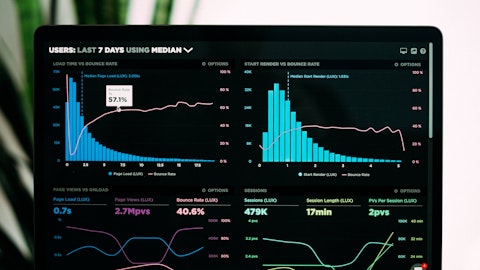In this article, we discuss the 10 undervalued energy stocks to buy according to hedge funds. If you want to skip our detailed analysis of the energy sector, go directly to 5 Undervalued Energy Stocks to Buy According to Hedge Funds.
Oil prices have reached sky-high valuations since Russia launched its invasion of Ukraine in late February. Brent crude recently went up to almost $140 per barrel, which is the highest it’s been since 2008. It trades at around $131 a barrel as of March 7. Russia, the oil giant supplying 40% of Europe’s natural gas, has threatened to halt supplies in response to restrictions imposed by the West. As Germany halted the certification of Nord Stream 2 pipeline, Russia has threatened to cease its supply of natural gas to Europe through the Nord Stream 1 pipeline, which is currently operating at full capacity. Russian Deputy Prime Minister Alexander Novak said that any attempts to ban Russian energy exports would result in “catastrophic consequences for the global market”, and predicted that oil prices would surge uncontrollably, reaching around $300 per barrel.
The energy sector acts as the literal and figurative heart of the world economy, and energy price changes have far-reaching effects that reverberate through every industry in every region around the globe. With all this chaos, there’s also some money to be made in the slim opportunity investors have in the shape of rising oil prices. Energy companies stand to directly benefit from these trends, and some of the biggest names in the industry include Exxon Mobil Corporation (NYSE:XOM), Chevron Corporation (NYSE:CVX) and Shell plc (NYSE:SHEL), along with others discussed below.
It is also pertinent in these times of economic upheaval to keep an eye out for stocks trading at a discount to their intrinsic value. That is why we picked the 10 undervalued energy stocks that hedge funds are snapping up on.

Photo by Zbynek Burival on Unsplash
Our Methodology
For the following list, we picked energy companies with PE (price/earnings) ratio of less than 20, with the highest number of hedge funds holding stakes in them. Hedge fund sentiment around each stock was derived from Insider Monkey’s database of 924 elite hedge funds.
10 Undervalued Energy Stocks to Buy According to Hedge Funds
10. Suncor Energy Inc. (NYSE:SU)
Number of Hedge Fund Holders: 33
PE Ratio (as of March 7): 15.11
Starting off our list is Suncor Energy Inc. (NYSE:SU), which operates as an integrated energy company based in Calgary, Canada. It deals in the exploration, production and marketing of crude oil in Canada and around the world. As of March 7, shares of Suncor Energy Inc. (NYSE:SU) have surged 49.43% in the last year, and 78.30% in the last six months. Suncor Energy Inc. (NYSE:SU) currently pays a dividend yield of 3.99% as well and doubled its dividend payments during 2021.
In the fourth quarter, 33 out of 924 elite hedge funds tracked by Insider Monkey held shares with a combined value of $1.30 billion in Suncor Energy Inc. (NYSE:SU). This is up from 32 bullish hedge funds in the preceding quarter. Arrowstreet Capital was the top shareholder in the Canadian energy firm in Q4 2021, with 9.38 million shares valued at $234.9 million, signaling a 6% increase in holding from the previous quarter.
Suncor Energy Inc. (NYSE:SU) boasts ample reserves of crude oil, something most of the firm’s competitors do not. With crude oil demand set to remain consistent and prices poised to go up, Suncor Energy Inc. (NYSE:SU) is well-positioned to benefit from this trend. In February, RBC Capital analyst Greg Pardy downgraded the firm to ‘Sector Perform’ from ‘Outperform’, with a revised price target of C$42, up from C$37, whilst noting that the firm’s Q4 results were largely in-line with his expectations.
In addition to Exxon Mobil Corporation (NYSE:XOM), Shell plc (NYSE:SHEL) and Chevron Corporation (NYSE:CVX), Suncor Energy Inc. (NYSE:SU) is an undervalued energy stock on the radar of investors.
9. Energy Transfer L.P. (NYSE:ET)
Number of Hedge Fund Holders: 36
PE Ratio (as of March 7): 5.47
Energy Transfer L.P. (NYSE:ET) features next on our list of undervalued energy stocks to buy according to hedge funds. Insider Monkey’s database of 924 elite hedge funds was scoured to find 36 hedge funds with bullish bets on Energy Transfer L.P. (NYSE:ET) in the fourth quarter, with combined stakes worth $635.6 million. This shows a positive trend from last quarter, where 29 hedge funds held positions worth $727.7 million in the firm.
Energy Transfer L.P. (NYSE:ET) deals in the ownership and operation of natural gas pipelines in the United States, and sells natural gas to independent power plants, electric utilities, local distribution and other marketing companies, and industrial end-users. Energy Transfer L.P. (NYSE:ET) posted an EPS of $0.30 in the fourth quarter, beating estimates by $0.08. Quarterly revenue was up 85.94% year-on-year, standing at $18.66 billion which outperformed estimates by $2.04 billion.
In February, Mizuho analyst Gabriel Moreen maintained a ‘Buy’ rating on Energy Transfer L.P. (NYSE:ET) shares, and upped the price target to $14 from $13. The analyst noted that the firm posted positive commercial updates in several key areas, highlighting its strong growth potential in the current market environment. As of March 7, shares of Energy Transfer L.P. (NYSE:ET) gained 29.73% in the last 12 months, and 26.73% year to date.
Miller Value Partners, an investment firm, talked about Energy Transfer L.P. (NYSE:ET) in its Q2 2021 investor letter. Here’s what the fund said:
“Energy Transfer LP (ET) rose over the period along with the price of oil climbing 40.59% over the period. The company received positive news that the Dakota Access Pipeline project would not be shut down while the Environmental Impact Statement by the US Army Core of Engineers is drawn up. Energy Transfer reported strong 1Q results with revenue of $17B surpassing expectations for $11.8B with adjusted earnings before income, taxes, depreciation and amortization (EBITDA) hitting $5.04B ahead of consensus of $2.77B. The company raised full year adjusted EBITDA guidance to $12.9-13.3B from $10.6-11.0B previously, with the increase largely related to the benefits realized from Winter Storm Uri. The company paid down $3.7B in debt during the quarter, using strong cash flow to reduce leverage. The company also announced the issuance of $900M in 6.5% Series H perpetual preferreds with the company using the proceeds to repay debt and for general purposes.”
8. Arch Resources, Inc. (NYSE:ARCH)
Number of Hedge Fund Holders: 40
PE Ratio (as of March 7): 7.74
Arch Resources, Inc. (NYSE:ARCH) operates surface and underground coal mines in the United States, with a total of 7 active mines as of the end of 2021. It sells thermal and metallurgical coal to the utility, industrial, and steel producers around the globe.
On February 16, BMO Capital analyst David Gagliano kept an ‘Outperform’ rating on Arch Resources, Inc. (NYSE:ARCH) shares, and raised the price target to $140 from $115. The analyst noted that shares of the firm remain inexpensive even after a ‘sharp rally’, and its capital returns program will enable significant shareholder returns, and also represent a meaningful de-risking capital allocation plan. As of March 7, shares of Arch Resources, Inc. (NYSE:ARCH) have gained an impressive 201.40% in the last 12 months, and 77.46% in the last 6 months.
In the fourth quarter, Arch Resources, Inc. (NYSE:ARCH) reported EPS figures of $13.25, which beat analysts’ forecasts by $0.34. The company raked in $805.70 million in revenue for the quarter, which beat consensus estimates by $90.56 million and signaled an increase of 123.45% from the year-ago period.
40 hedge funds were seen holding shares of Arch Resources, Inc. (NYSE:ARCH) in the fourth quarter of 2021. The total value of these holdings stood at $578.6 million. This shows increasing investor confidence from Q3 where 31 hedge funds held positions in the coal firm.
7. Shell plc (NYSE:SHEL)
Number of Hedge Fund Holders: 41
PE Ratio (as of March 7): 10.03
Hedge funds were seen buying Shell plc (NYSE:SHEL) in the fourth quarter, where 41 hedge funds held combined positions worth $2.63 billion. This is in contrast to 33 hedge funds with bullish bets on the energy firm a quarter ago, with aggregate stakes worth $2.05 billion.
Shell plc (NYSE:SHEL) is a Dutch energy company which deals in petrochemicals around the world. It posted an EPS of $1.66 in the fourth quarter, beating consensus estimates by $0.41. Q4 revenue for the firm was up 93.87% from the prior-year period and above analysts’ forecasts by $26.62 billion, coming in at $85.28 billion. As of March 7, Shell plc (NYSE:SHEL) saw its share price gain 17.58% in the last 12 months, and 18.80% in the year to date.
Cowen analyst Jason Gabelman in February kept an ‘Outperform’ rating on Shell plc (NYSE:SHEL) shares, and raised the price target to $58 from $53. Gabelman sees the company exploring ways to upgrade its cash return framework, the benefits of which could come with Q2 2022 earnings. BofA analyst Christopher Kuplent initiated Shell plc (NYSE:SHEL) with a ‘Buy’ rating in February, and a price target of $66, after the firm changed its name to Shell plc from Royal Dutch Shell, and completed the collapse of its dual listings.
On February 28, as Russia invaded Ukraine, Shell plc (NYSE:SHEL) announced that it would exit its joint ventures with Russian firm Gazprom (OGZPY) and its related entities, whilst also terminating its involvement in the Nord Stream 2 pipeline. Shell plc (NYSE:SHEL) had around $3 billion in non-current assets in its Russian ventures at the end of 2021.
Goehring & Rozencwajg Associates, an investment management firm, mentioned Shell plc (NYSE:SHEL) in its Q3 2021 investor letter. Here‘s what the fund said:
“Royal Dutch Shell’s ESG challenges continue unabated. A Dutch court ruled in May that Royal Dutch Shell must cut its CO2 output by 45% by 2030 to align their policies with the Paris Climate Accord. In a statement issued after the verdict, a Shell spokesperson acknowledged that “urgent action is needed on climate change and the company is accelerating efforts to reduce emissions.” If the pressure from the Dutch court system was not enough, an activist shareholder has proposed breaking the company apart to address ESG concerns. On October 27th, Third Point Management announced the following.
“If Shell pursues this type of strategy it would probably lead to an acceleration of carbon dioxide reduction. […] Breaking Shell into two operating units would create a standalone legacy energy business (upstream, refining, and chemicals) that could slow capex beyond what is has already promised, sell assets, and prioritize return of cash to shareholder which can be reallocated into low-carbon areas of the market.”
Shell has already cut spending dramatically over the last decade. After having peaked at $39 bn in 2013, upstream capital spending fell to only $17 bn in 2020 – a drop of nearly 60%. Spending has barely recovered in the three quarters of 2021. A lack of spending has already impacted production. Proforma for the 2016 acquisition of BG Group, Shell’s total production has fallen 13% since capital spending peaked in 2013. These trends are accelerating: Shell’s production over the first nine months of 2021 have fallen 7% compared with the same period last year.
If Royal Dutch Shell’s upstream capital spending remains at today’s depressed levels, we estimate the company will only be able to replace 30% of production with new reserves and that production will fall 40% over the next nine years. If spending is further curtailed (as is being proposed), Shell’s oil and natural gas production would collapse – something that may have already started.”
6. Ovintiv Inc. (NYSE:OVV)
Number of Hedge Fund Holders: 44
PE Ratio (as of March 7): 9.16
Ovintiv Inc. (NYSE:OVV) was given a ‘Buy’ rating by Truist analyst Neal Dingmann on February 28, with the analyst holding that the firm was among very few in his coverage which look set to maintain stable production in 2022, whilst also maintaining capital spending. As of March 7, Ovintiv Inc. (NYSE:OVV) saw its share price gain 75.20% in the last 12 months, and 44.63% year to date.
Based in Colorado, USA, Ovintiv Inc. (NYSE:OVV) deals in the exploration and production of natural gas, oil, and natural gas liquids. The firm’s EPS for Q4 was $1.25, missing estimates by $0.39. Quarterly revenue of $3.34 billion was above analysts’ forecasts by $1.38 billion, and up 118.52% from the year-ago period.
Out of all the hedge funds tracked by Insider Monkey, 44 were long Ovintiv Inc. (NYSE:OVV) in the fourth quarter, with aggregate positions worth $1.07 billion. The same number of hedge funds were bullish on the energy firm a quarter ago as well.
In its Q4 2021 investor letter, investment firm Miller Value Partners discussed Ovintiv Inc. (NYSE:OVV), stating:
“The outlook for high multiple favorites depends to a great degree on interest rates. Warren Buffett likened interest rates to the force of gravity for asset prices. At current low levels, high valuations on long-duration assets can be justified. If interest rates move up, the adjustment will be painful. Market action early in the new year, with the swift moves up in interest rates and down in the Nasdaq, offers a taste of the medicine.
We underwrite all our names to have sufficient upside even if risk-free rates move up to 3% (a scenario, not a forecast!). As we evaluate the opportunity set, we find more attractive prospects in the classic value names. We often hear that people think value investing is dead, which only strengthens our conviction. Our gross exposure to classic value has risen from 44% a year ago to 62% currently.
One new name that illustrates the potential we see is Ovintiv (OVV), an oil and gas producer. We’ve seen a huge shift in the industry away from growth towards returns on capital, cash generation, and capacity discipline. OVV exemplifies the change.
OVV’s new CEO Brendan McCracken says: “We are at the forefront of driving innovation to produce oil and gas from shale both profitably and sustainably. We will generate superior returns and free cash flow by continuously improving capital efficiency and expanding margins while driving down emissions. We will deliver that value to our shareholders through disciplined capital allocation.”
Based on crude at $65 (well below the current $83.82 as of 1/14/22), the company guides to free cash flow generation of $11B over the next 5 years and $21B in the next 10 years. The company’s market cap is currently $10B and its enterprise value is $16B. It’s returning a significant portion of the capital to shareholders. If crude averages $70 in 2022, the company will return $700M to shareholders (in addition to paying down a significant amount of debt), which implies a yield of 7% at the current $39.53 price. In other words, there’s a good shot the company will return nearly its entire market cap to shareholders over the next 5 years.”
Along with Exxon Mobil Corporation (NYSE:XOM), Shell plc (NYSE:SHEL) and Chevron Corporation (NYSE:CVX), Ovintiv Inc. (NYSE:OVV) is a top undervalued energy stock to buy.
Click to continue reading and see 5 Undervalued Energy Stocks to Buy According to Hedge Funds.
Suggested articles:
- 15 Best Semiconductor Stocks to Buy Now
- Top 20 Gold Mining Companies
- 15 Best Technology Stocks To Buy Now
Disclosure. None. 10 Undervalued Energy Stocks to Buy According to Hedge Funds is originally published on Insider Monkey.





